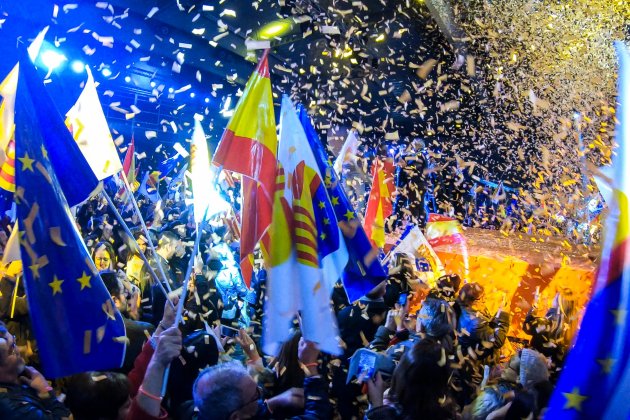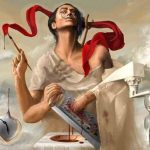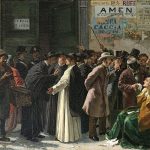Catalonia: the fake Utopia?
The current narrative around an independent #Catalonia may be just a fake Utopia. In the new Netflix documentary “Two Catalonias” (released Sept. 28, 2018, co-directed by Álvaro Longoria and Gerardo Olivares) John Carlin says that in 1998 the independence movement in Catalonia was just 3 old guys and a dog. And that nobody took them too seriously. A lot has changed in the last 20 years. Carlin’s image is very useful because it points out two realities: there has always been pro-independence gesturing in Catalonia, but it has been maudlin, aspirational and largely utopian.
The difference today is that some politicians have concocted a fake Utopia out of resentment and biased information. The documentary successfully presents an image of a prosperous and sophisticated European society bitterly divided over a rather provincial issue. And very much like any hillbilly infighting, it is harrowingly difficult to resolve once the first shots have been fired.

The right to self-determination
The film contains a series of interviews and footage from protests and political rallies from the December 21st, 2017 snap election. It aims to reflect a detached and objective stance around the running conflict. All points of view have their place. In this endeavor the documentary succeeds. But it lacks in historical perspective.
One salient point in particular is the divisive issue of self-determination. Political self-determination is a human right recognized in the United Nations Charter. And further, the Catalan separatists espouse a strong liberal view of it as a fundamental and inalienable right. At first sight this sounds reasonable, even attainable.
But this is not the only way to analyze this. First, according to the prevailing realist theory of international rights, territorial integrity has precedence over self-determination. Thus, the UN directive recognizes said right with no limitations only for special cases of colonies, conquered or oppressed peoples. Catalonia is not a colony of Spain. In this case the Spanish Constitution and sovereignty apply. As with most liberal democracies, in Spain this right is not recognized since the unity of the state is the founding principle.
Second, the status as an independent state does not come just from declaring independence. It only happens when and if the international community of nation-states recognizes you as such. No state would recognize a splinter state that forced separation by claiming a non-existent self-determination right or otherwise. The contrary would mean accepting the breaking up of one of its members states, to whom they have pledged respect for its statehood. Consequently, no state in the European Union has recognized the Catalan claim to independence.
However, the Catalan separatists would argue that Catalonia is indeed an oppressed colony of Spain, referring to a dispute that dates back to 1714.
The 1714 problem in Catalonia
The Kingdom of Spain was created in the 15th century when Isabella of Castile and Ferdinand of Aragon married and united their kingdoms according themselves equal standing and power. Catalonia was at the time a region of Aragon under the rule of its own minor nobility, which had pledged serfdom to the king of Aragon.
By marriage of the princess heiress Joanna to Philip, the crown of Spain became part of the Hapsburg dynasty. The last Spanish Hapsburg ruler Charles II died without issue in 1700. Then the Spanish War of Succession ensued. Bourbon France and Hapsburg Austria both claimed the right to the Spanish throne (and its sprawling American empire). The Bourbons won the war in 1714 after the fall of Barcelona. The European warring powers then convened in Utrecht to accord peace terms, under which Spain ceded territories in exchange for recognition and peace.
The Catalan separatists claim today that the Castile-Aragon union agreement was voided because of the War of Succession. Catalonia was on the losing side of the war. That is why they understand that what ensued after the peace of Utrecht was an outright occupation and colonization by Bourbon force. However, not all of Catalonia was on the losing side, since many, including the local government, did support the Bourbon pretender from the start.
After 1714 the new Bourbon king, incensed by the Catalan resistance, embarked on a political plan of remaking Spain into a centralized and absolutist monarchy in the image of France. His regime stripped the regions of autonomy and local aristocrats were made subservient to the King. The events of 1714 and its aftermath have served as a catalyst for a strong national identity in Catalonia.
Franco dictatorship and post-Franco
The treaty of Utrecht and the Bourbon kingdom of Spain held together with many ups and downs for the next two centuries. It survived the occupation by Napoleon and the loss of its worldwide empire. But the end came when Bourbon King Alphonse XIII abdicated and the Second Spanish Republic was declared in 1931. Catalonia briefly considered separation, but was a part of the new Republic from the start.
The King gone, after the 1933 election the Republic came under control of the right wing conservative parties. This situation bothered the Catalan local government, in the hands of left-leaning liberal parties. Then president Companys decided to unilaterally declare independence in 1934 and call into being the Catalan State (albeit within a Spanish Federal Republic).
However, this political adventure held for less than a day. The central government disolved the executive and jailed Companys. These rebellious attempts in Catalonia were a part of the reasons why Franco and other military leaders decided to orchestrate a putsch to “restore order”. Then, a grueling civil war ensued, which the Republicans lost. The result was the Franco dictatorship.
The generalized view in Catalonia today is that after the civil war Franco made a point of humiliating and oppressing Catalonia, and of rooting out its identity and language. That may be true, but the reality is more complex. The same oppression happened in the whole of Spain during the 40 years of dictatorship, which tried hard to create a centralized Spain under one single Castilian identity. Galician and Basque peoples suffered the same forced homogenization. Probably Catalonia was most affected because it was more liberal than other regions.
Autonomous Catalonia
In 1975 Franco died and put in his place a new Bourbon King, Juan Carlos I. Franco had hoped that the King would continue as the head of the dictatorial system. But the King decided to transform Spain into a democratic parliamentary monarchy under the new Constitution of 1978. This period, called “The Transition”, resulted in the restoration of the autonomous regions with self-government in Spain, similar to the pre-civil war republican regime.
Thus, Catalonia became an autonomous region and approved the new Constitution and monarchy in a popular referendum with over 95% support. The new Catalan government assumed all the devolved powers quickly, and became a model of openness, democracy, development and self-rule in Europe. Spain became a member-state of NATO in 1982 and of the European Union in 1986.
However, the new Catalan autonomous government also embarked in a grand plan to restore language and national identity. A plan that would thrive in the continuous emphasis of the Catalan “difference” and superiority vis-à-vis the Spanish. Thus the plan carried the separatist idea in its design. It was reinforced by a perception of Catalan “otherness” and suspicion on the Spanish side as well. In 2011 during the global financial crisis these contradictions would blow up in the face when “money issues” soured the friendship.
Zapatero and Rajoy
Prime minister Zapatero (2004-2011) made two consequential miscalculations during his government. The first was to underestimate the severity of the 2008 crisis until it was too late to take meaningful action. The second was to promise full support for a new autonomic constitution for Catalonia (the “Estatut”).
The new Estatut was written and voted in the Catalan Parliament, and then went on for ratification by the Spanish Congress, which it passed with Zapatero’s blessings. But the Estatut had included some clauses that were probably unconstitutional: the primacy of the Catalan language over Spanish, and the right to self-determination. Zapatero’s opponent Rajoy built a political platform around opposition to the new Estatut. Parts of the Estatut were finally declared unconstitutional by the Supreme Court. Catalans view this event as an imposition against the popular will.
When Zapatero was defeated in the general elections and Rajoy became prime minister, he was very much invested in the suppression of Catalan plans and claims. The more the Catalan problem grew, the more justification he garnered for his continued leadership and power. The 2008 crisis hit Catalonia hard and when then Catalan president Mas went to ask for a bail-out and financial restructuring in 2012, Rajoy was only too happy to deny him claiming solidarity with the hardship in the rest of Spain.
The discord between Mas and Rajoy was the last straw for the Catalan government. Mas embarked then in a project to tap into the latent separatist sentiment as an effective way to deflect from the crisis, blame an external enemy made for the part (Rajoy), and minimize the years of mismanagement and corruption on his side. The plan would in time result in the illegal referendum and the failed unilateral declaration of independence of October 2017.
The referendum of October 1st
The popular mobilization for independence started by Mas increased support for the separatist idea. But not enough to win a popular majority in the autonomic election of 2016. Thus Mas was forced to craft a coalition with a radical minority party (CUP) to be able to form a government. The result was that CUP imposed a new president instead of Mas: the radical separatist Puigdemont.
Puigdemont seemed at first just a placeholder for Mas, but soon changed the tone to an open confrontation with the central government. Electoral law gave him a thin majority in the Catalan Parliament even if the popular vote was just over 47% for the separatist cause. Instead of recognizing that popular support was not material, he pushed the legislature to pass “transition” laws and organize a referendum that was ruled illegal by the Supreme Court.
The illegal referendum of October first 2017 took place despite the Court’s ruling, central government’s opposition and the national police resorting to force in a most regrettable episode.
Independence and intervention
The referendum was not only illegal, but it lacked the necessary democratic guarantees. Further, less than 45% of voters cast ballots. In spite of all this Puigdemont moved to declare independence. Rajoy, outmaneuvered and crossed, responded by suspending the Catalan government and calling snap elections.
Puigdemont and others immediately fled the country to avoid being arrested, while others are currently jailed pending trial. Some have denounced that the judicial system may have overreached in imposing so harsh cautionary measures. Others think that the courts has been politicized.
The new election of 21st December 2017 failed again to give the separatists a popular majority. What is more, the anti-separatist party Ciutadans under leadership of Inés Arrimadas won the election, but was unable to form a stable government. A new coalition of parties pieced together with a diminished CUP formed a government with no popular majority base and no clear mandate. Puigdemont forced the designation of Quim Torra as a puppet president who is now bent on a new course of confrontation.
Meanwhile prime minister Rajoy lost power after a successful no-confidence vote over corruption allegations. Former opposition leader Sánchez led the new Spanish government. But for that he needed the support and votes of the Catalan separatist parties in Congress. Thus Sánchez seems weak and beholden to the will and whims of the separatists. All the while the general opinion in Catalonia is that the secessionist project has irreparably failed and a new direction is needed.
The need for constitutional reform
The Catalan separatist movement is the result of several circumstances. First the creation of a fake Catalonia Utopia by misleading the population. The Catalan people have been told by their leaders that since 1714 Catalonia has been colonized by Spain, that the financing model is unjust, that Europe would accept an independent Catalonia with open arms, that there is an homogeneous Catalan society and that independence is the solution to all problems. Positions boosted by a pervasive national narrative of “Spanish failure”, the growth of social media activism and a new online public sphere created since the 15M movement.
The reality is different. Catalonia is not a colony of Spain. She enjoys a high level of self-government even by European standards. The autonomic financing system can be made better but solidarity is important too. No state in Europe has recognized or will ever recognize a new state imposed by force against the Spanish Constitution. Further, Catalonia is in fact a very diverse, open and multicultural society. Migrant workers from all of Spain support the economic prowess of the region. And last but not least, independence is just a problem imposed by a sectarian group with a dated ideology, rather than today’s solution for the population.
Secondly, the Catalan situation is also a result of the growing discontent with global liberal democracy since 2008. A discontent which radical and populist parties use to sow division, hatred and misinformation. It is easy to pin all evil on others. And to view the Spanish State as only an enemy. The current president Torra is one example of the rather smallish but xenophobic and supremacist wing of the movement. The growing populist and nationalist tendency is a serious problem not just in Spain, but all over Europe.
The urgent reality is that Spain needs to work on a project of constitutional reform. Do we want to allow regions to exercise self-determination? Do we want a new federalist model, or a centralized political model? Can we reconcile local grievances and differences with the solidarity needed in a modern democracy? Is there a model to ensure unity and diversity? How should immigration and integration be made acceptable to all? Those are big questions. The only way is for all the Spanish people to participate and answer them in the ballot box.
What do you think?
Leave your comments below, contact me or suscribe to the mailing list:
Recommended further reading:
- Elliott, John H. Scots and Catalans: Union and Disunion. Yale University Press, 2018.
- Minder, R. The Struggle for Catalonia: Rebel Politics in Spain. Hurst, 2017.
- Castro, L. (editor), et al. What’s Up With Catalonia? The causes which impel them to the separation. Catalonia Press, 2013.





